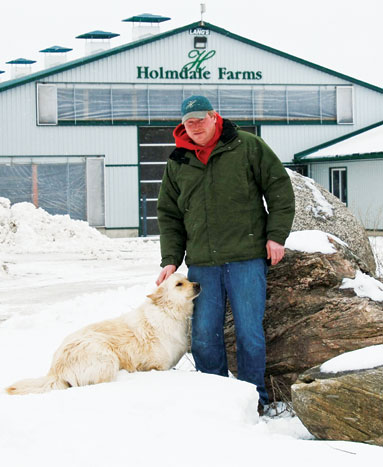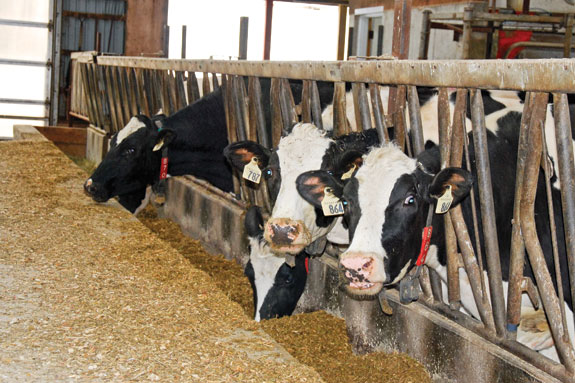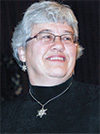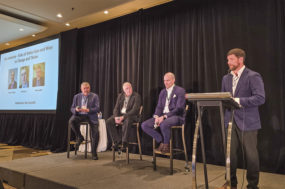The dairy herd consists of 118 milking cows, with an additional 55 dry cows and pregnant heifers. Calves and replacement heifers bring the herd total to close to 250.

All are registered Holsteins, classified for type, but Todd stresses that it is a commercial, not show herd. “It’s what ends up in the milk tank that counts,” he says. The herd is part of the Canadian Quality Milk Program.
The farm had a milking parlour, but it was worn out, so Todd began looking at other options. He took a course on barn building and made extensive trips to visit and observe different systems in the area.
He really did not expect to use robotic milkers. “I was the biggest skeptic there is,” he laughs, but after visiting a number of robot-equipped farms, he changed his mind and installed two robots in the new barn he built.
He is pleased with the results. Cows can choose their own milking interval – more frequent milking increases production and the robots milk each quarter as required, so milkers are not pulling on empty quarters.
Radio frequency identification (RFID) tags keep track of each cow – how often she comes for milking, her production, the amount of feed she is allowed, her health and motion records – all making it easier for the farm’s staff to monitor each one.

Milking occurs on average 2.7 times per day, with a refusal rate of one time per day, where cows are checked by the robot but are not yet eligible for milking. Production averages 34.5 litres per day with 4.05 percent butterfat.
This new barn has a number of features to provide the milking herd with greater comfort. It is a freestall barn, divided by a raised drive-through aisle for feeding into bunks.
The bunks eliminate the necessity to push up feed as often. An occasional sweeping of the alleyway is all that is required. Another advantage of this raised platform is to give Todd and his staff a better vantage point from which to observe cows for any problems that might occur.
The stalls are tail-to-tail, although Todd has decided his next one will be head-to-head, which gives cows more lunge room for getting up.
The stalls are equipped with sturdy water beds and bedded with softwood shavings, which are topped off on a weekly basis. According to Todd, the water beds are softer and easier to clean; they move with the cows and are less abrasive.
Cows are able to self-groom with large brushes mounted for their convenience. They also enjoy a shower if the temperature is higher than 21°C. “They love it,” Todd states.
Todd works 1,100 acres, most of it owned, and grows all his own feed (with the exception of premix pellets). Approximately 300 acres supplies the needs of the cows, with a further 150 acres of alfalfa. The remainder is cash cropped in a mix of corn, soybeans, soft red winter wheat and white beans.
The cows are fed a total mixed ration (TMR) made with corn silage, haylage, dry hay, straw, ground dry corn and canola/soy meal. “The cows are eating 24 kilograms TMR on a dry matter basis. The actual ration is 44 percent moisture so the cows are consuming 54 kilograms of ration or 120 pounds,” Todd explains.
Another major change to the dairy operation is in the rearing of calves. The old barn was renovated to house calves from birth to breeding age.
Baby calves are housed in individual pens for a few days, where they learn to drink from bottles. They are then grouped with four or five others in a small pen equipped with a Forster-Technik automatic calf feeder system.
They are fed milk replacer with 26 percent protein, 19 percent fat (each calf consumes approximately 2.5 bags before weaning) and started on an 18 percent pelleted ration. Milk is mixed for each calf according to the RFID tag and the calves can feed as desired rather than on an arbitrary schedule.
After about 10 days, the calves are housed in larger areas. The volume of milk increases to 13 litres at 21 days old, then decreases along with the concentration of milk powder from 160 grams to 50 grams per litre of water at 64 days old.
By this time, the calves are well started on pellets and TMR, and Todd weans them in groups of five. He has no problems using this system. “You never hear them bawl,” he comments.
He also states that because calves are introduced to ration gradually before weaning, there is no setback. “Calves just keep going forward,” he says.
Calves are kept in small groupings for about two months, then gradually combined in larger groupings and fed TMR free-choice.
By breeding age at 14 months, they are in groups of 25 to 30. Todd finds that calving at 23 months makes no real difference in production versus leaving them a bit older.
Once confirmed pregnant, heifers move down the road to a dry barn and enjoy roaming pastures (in season) prior to returning to the main facility for calving. Todd has plans to build another dairy barn in a couple of years, which will allow all the cattle to be accommodated at the home farm.
Todd’s father, George, continues to help on the dairy, mostly with tractor work. There are also five full-time employees, some of which have worked there for many years.
Todd appreciates their contributions. “These are a great bunch to work with, just like family,” he states. Todd’s young sons, Keaton, 10, and Chapman, 8, also are beginning to help with a few chores. Daughter Grace, 5, will no doubt join in as she gets old enough.
Now that the dairy’s renovations are complete, Todd’s focus is on a personal project – he and his wife, Sarah, are in the process of building a new house on the property.
This has been planned by Sarah, an interior designer, and features a fireproof room in the basement for Todd’s office and recordkeeping.
Although his business is demanding, Todd still finds time to coach a hockey team and plans to continue. PD
Alice Guthrie is a freelance writer from Hagersville, Ontario.
PHOTOS
TOP: Since assuming ownership of the home farm in 2007, Todd Holm has incorporated a number of new features, such as a new freestall barn with robotic milkers and automated calf feeders.
BOTTOM: A raised drive-through aisle allows feed to be dropped into bunks, eliminating the need to push up feed as often. It also provides Todd a better vantage point for checking the herd. Photos courtsey of Alice Guthrie









